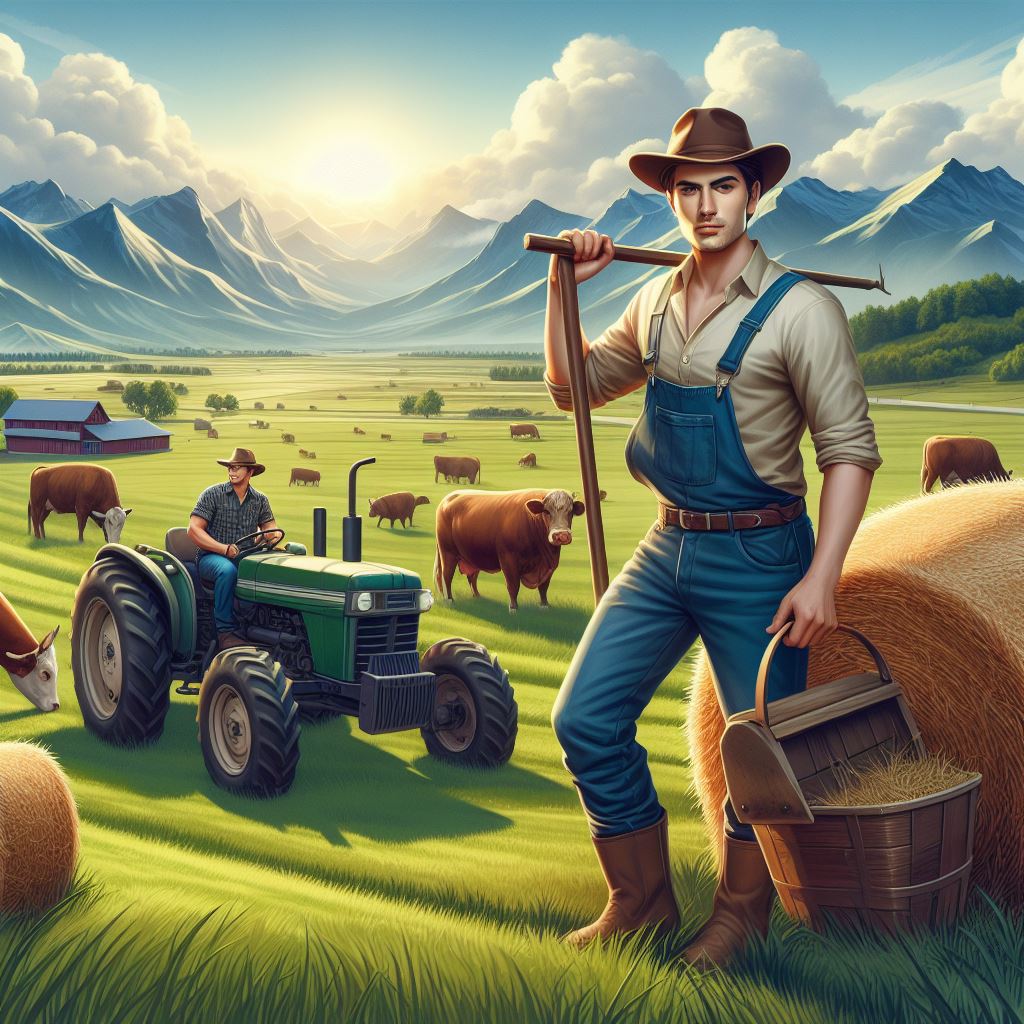Introduction
Brief overview of the importance of pasture rotation for farming
Pasture rotation is a vital practice in farming for maximizing productivity and maintaining healthy pastures.
Role of effective fencing in pasture rotation
Effective fencing plays a crucial role in successful pasture rotation strategies.
Without proper fencing, livestock may not be contained, leading to overgrazing and pasture degradation.
A well-designed fence system allows farmers to control grazing areas and implement a systematic rotation plan.
By dividing pastures into smaller sections and moving animals regularly, farmers can prevent overgrazing.
This helps to preserve the quality of the grass, improve soil health, and reduce parasite load.
In addition, pasture rotation allows for better distribution of manure, minimizing runoff and nutrient loss.
Effective fencing also helps to protect waterways and sensitive areas from livestock access.
By strategically placing fences, farmers can ensure animals have access to fresh vegetation while avoiding environmental damage.
Furthermore, properly constructed fences reduce the risk of livestock injuries and discourage predators.
Investing in a reliable fence system is essential for the long-term success of pasture rotation practices.
In the following sections, we will explore different types of fencing materials and techniques for effective pasture rotation.
We will discuss factors to consider when choosing a fence, maintenance requirements, and cost-effective options.
Through proper fencing, farmers can optimize grazing management, improve animal health, and increase farm productivity.
Benefits of Effective Fencing in Pasture Rotation
Effective fencing plays a crucial role in successful pasture rotation systems.
Transform Your Agribusiness
Unlock your farm's potential with expert advice tailored to your needs. Get actionable steps that drive real results.
Get StartedBy implementing proper fencing, farmers and ranchers can reap numerous benefits that contribute to the overall management and health of their grazing land.
Improved management of grazing patterns
One of the primary advantages of effective fencing in pasture rotation is the ability to prevent overgrazing in specific areas.
By dividing the pasture into smaller sections with the help of fences, livestock can be limited in their access to certain areas.
This prevents them from continuously grazing on the same patch of land, allowing for the recovery and regrowth of vegetation.
In addition, effective fencing enables a more even distribution of grazing pressure.
Livestock tend to congregate in certain areas of the pasture, leading to uneven grazing patterns.
However, by strategically placing fences and creating smaller grazing areas, the animals are forced to graze in a more uniform manner, preventing the underutilization of some areas and overutilization of others.
Enhanced control over animal movements
Effective fencing provides farmers with greater control over the movement of their livestock.
It facilitates planned rotations, allowing farmers to systematically move their animals from one grazing area to another.
This helps to optimize the utilization of available forage, prevent overgrazing, and promote healthier vegetation growth.
Furthermore, fences enable the separation of different livestock groups.
This is particularly beneficial when raising multiple species of animals or when separating animals based on age, sex, or health conditions.
By having separate pasture areas for each group, farmers can better manage their herds and provide individualized care as needed.
Protection of sensitive areas
Efficient fencing is also crucial for the protection of sensitive areas within the grazing land.
By creating fences around water sources, trees, and riparian zones, farmers can ensure their preservation.
This prevents livestock from trampling these areas, leading to the preservation of vital water sources, nutrient-rich trees, and valuable riparian zones that support biodiversity.
In addition, proper fencing helps reduce soil erosion and compaction risks.
By preventing unrestricted animal access to certain areas vulnerable to erosion, such as steep slopes or fragile soils, farmers can significantly minimize the erosion and compaction of soil.
This, in turn, protects the integrity of the land and maintains its fertility.
Therefore, effective fencing plays a vital role in pasture rotation systems.
It not only improves the management of grazing patterns but also enhances control over animal movements.
Furthermore, it assists in the protection of sensitive areas, ensuring the preservation of water sources, trees, and riparian zones, while reducing soil erosion and compaction risks.
Farmers and ranchers should prioritize the implementation and maintenance of proper fencing to maximize the benefits and sustainability of their grazing land.
Read: Water Management in Grazing Fields
Showcase Your Farming Business
Publish your professional farming services profile on our blog for a one-time fee of $200 and reach a dedicated audience of farmers and agribusiness owners.
Publish Your ProfileTypes of Fences for Pasture Rotation
A well-designed and properly constructed fence is crucial for successful pasture rotation.
Different types of fences serve different purposes, and it’s important to choose the right kind of fencing for your specific needs.
Permanent Fencing
Permanent fencing, such as wooden or vinyl fences, offers durability and longevity.
They provide a significant physical barrier that helps contain livestock and prevent unwanted intrusions.
While they require initial investment and maintenance, they offer a long-term solution for pasture rotation and overall pasture management.
Electric fences, which can be used in conjunction with permanent fencing, offer an added psychological deterrent to animals.
These fences use a low-level electric shock to deter livestock from trying to breach the fence.
Electric fences are cost-effective, easy to install, and can be moved as needed for pasture rotation.
Temporary Fencing
Temporary fencing options, such as single-strand electric fences and temporary electric netting, offer flexibility and convenience for pasture rotation.
These fences can be quickly set up and easily moved to create temporary paddocks or divisions within a pasture.
They are ideal for rotational grazing systems where animals are moved frequently to prevent overgrazing.
Polywire or polytape is another temporary fencing option that provides a lightweight yet effective solution for temporary divisions within a pasture.
These materials are easily visible and can be installed using temporary posts or step-in stakes.
Polywire or polytape is a cost-effective choice for pasture rotation and can be easily rolled up and stored when not in use.
Most importantly, the choice of fencing for pasture rotation depends on factors such as your budget, specific needs, and management goals.
Permanent fencing options like wooden or vinyl fences offer long-term durability, while electric fences provide added security.
Temporary fencing options such as single-strand electric fences, temporary electric netting, and polywire or polytape offer flexibility and convenience for rotational grazing systems.
Assess your requirements and choose the fencing solution that best suits your pasture rotation needs.
Read: Pest Control in Healthy Pastures

Considerations for Effective Fencing
Durability and reliability
Fencing is an essential component of an effective pasture rotation system.
To ensure the success of your pasture rotation strategy, it is crucial to consider the durability and reliability of your fences.
When choosing fencing materials, opt for those that are resistant to animal pressure and can withstand various environmental conditions.
This will prevent animals from breaking or damaging the fences, ensuring the integrity of your rotational grazing system.
In addition to selecting the right materials, proper maintenance and regular inspections are essential.
By regularly checking your fences, you can identify any weak spots or signs of wear and tear.
Timely repairs and replacements will help maintain the effectiveness of your fencing system.
Visibility and safety
Visible fences are crucial for effective pasture rotation.
Animals need to be able to identify the boundaries of their grazing areas easily.
To enhance visibility, use visible markers and flags along the fence lines.
This will help animals recognize and respect the boundaries, reducing the risk of accidental breaches.
Another aspect of visibility and safety is ensuring that your fences do not pose any dangers.
Avoid using sharp or protruding objects that could injure animals or humans.
Smooth and rounded fence components should be prioritized to minimize the risk of injuries.
Ease of installation and mobility
Installing and maintaining fences can be time-consuming and labor-intensive, especially when it comes to pasture rotation.
Therefore, it is important to consider the ease of installation and mobility when selecting fencing options.
Portable or easily adjustable fencing systems are ideal for pasture rotation.
They allow you to easily move and adjust the fence lines according to your rotational grazing plan.
This flexibility saves time and effort while ensuring the efficient use of your grazing areas.
Furthermore, quick and simple installation techniques can significantly expedite the setup process.
Look for fencing options that do not require complex tools or extensive labor.
Showcase Your Farming Business
Publish your professional farming services profile on our blog for a one-time fee of $200 and reach a dedicated audience of farmers and agribusiness owners.
Publish Your ProfileThis will make the installation process hassle-free and more manageable, allowing you to focus on your pasture rotation strategy.
In essence, effective fencing for pasture rotation requires careful consideration of various factors.
Durability and reliability of materials, visibility and safety features, as well as ease of installation and mobility, are all vital for the success of your rotational grazing system.
By selecting the appropriate fencing options and adhering to proper maintenance practices, you can ensure the efficiency and effectiveness of your pasture rotation.
Read: Maximizing Grass Growth in Pastures
Tips for Implementing Effective Fencing Practices
Implementing effective fencing practices is crucial for successful pasture rotation and efficient grazing management.
By following these tips, farmers and ranchers can create a robust system that benefits both the animals and the land.
Planning and design
To begin, mapping out the pasture rotation areas is essential.
This allows farmers to divide the land into different sections, allowing for rotational grazing.
By rotating animals between these sections, it ensures that the pastures receive adequate rest and regrowth.
Planning for gate placements is also crucial.
Well-placed gates make it easier to move livestock from one pasture to another, reducing stress and minimizing the chances of escape.
Determining the appropriate fence heights, widths, and materials is another crucial step in effective fencing practices.
The fence height should be sufficient to contain the livestock comfortably.
This is especially important for taller animals or those with a tendency to jump.
The width of the fence should also be considered to prevent animals from getting stuck or injured.
The choice of fencing material should be based on the type of livestock and the desired level of durability.
Regular monitoring and adjustments
Once the fencing system is in place, farmers must regularly monitor grazing patterns and animal behavior.
Observe how the animals utilize the available pasture and assess if any adjustments to the fencing system are necessary.
By observing the livestock, farmers can identify any potential issues such as overgrazing or underutilization of certain areas.
Regular monitoring allows for prompt action to maintain the health of the pasture and ensure adequate forage availability.
Flexibility is key when implementing effective fencing practices.
As farmers gain insights from regular monitoring, they should be ready to modify fence placements as needed.
This may involve creating temporary fencing to subdivide larger pastures or adjusting gate positions for better access.
By being adaptable, farmers can respond to changing needs and make the most of their resources.
Training animals
Proper training of livestock is vital for the success of pasture rotation and effective fencing practices.
Electric fences are commonly used in rotational grazing systems as they provide a visible and effective deterrent.
When introducing electric fences, it is important to familiarize the animals gradually.
Begin by allowing them to explore the perimeter while ensuring their safety.
Over time, they will associate the fence with a mild electric shock and learn to avoid it.
Additionally, livestock must be handled and trained properly to respect fencing boundaries.
This involves using techniques such as pressure and release to teach the animals to yield to the fence.
Regular interaction and reinforcement help establish a clear understanding of the boundaries, minimizing the likelihood of them challenging or attempting to breach the fence.
In fact, implementing effective fencing practices is essential for successful pasture rotation and grazing management.
Through careful planning and design, regular monitoring, and proper animal training, farmers can create a well-managed grazing system that promotes healthy pastures and content livestock.
Read: Balancing Pasture Nutrition Needs
Case Studies/Examples
Success stories of farmers using effective fencing in pasture rotation
- Farmer John increased his livestock’s health and productivity through proper fencing and pasture rotation.
- Using strategic fencing, Farmer Sarah maximized her pasture’s potential and reduced feed costs.
- By implementing effective fencing techniques, Farmer Mark achieved sustainable grazing practices and improved soil health.
- Through careful planning and fencing, Farmer Jane successfully prevented overgrazing and maintained healthy pastures.
- Farmer Mike’s utilization of rotational grazing and well-maintained fences resulted in increased forage availability and livestock weight gain.
Challenges faced and lessons learned by farmers during the implementation process
- Farmers often faced initial resistance from livestock to adjust to new grazing areas.
- Proper fence maintenance became crucial as wear and tear could compromise pasture rotation effectiveness.
- Some farmers experienced issues with weeds invading pastures due to improper fencing practices.
- Inadequate planning and limited knowledge about grazing patterns led to inefficiencies in pasture rotation.
- Farmers learned to adapt fencing techniques to suit their specific livestock and pasture conditions.
- Managing water access within rotation systems required additional planning and unique fencing setups.
- It was essential for farmers to regularly monitor grazing progress and make necessary adjustments to fencing layouts.
Through success stories and challenges faced by farmers, the effectiveness of proper fencing in pasture rotation becomes evident.
By implementing strategic fencing techniques, farmers can achieve remarkable outcomes in terms of livestock health, productivity, and pasture sustainability.
Learning from the experiences of these farmers can provide valuable insights for others looking to optimize their grazing management.
Conclusion
Recap of the Importance of Effective Fencing in Pasture Rotation
- Grazing Efficiency: Well-designed fencing optimizes pasture rotation, enhancing livestock access to fresh forage for sustained grazing.
- Resource Utilization: Effective fencing facilitates strategic pasture division, preventing overgrazing and promoting resource efficiency.
Encouragemen for Farmers to Implement Proper Fencing Techniques
- Enhanced Productivity: Elevate farming practices by embracing effective fencing for improved pasture rotation and overall livestock management.
- Sustainable Grazing: Proper fencing contributes to sustainable farming, ensuring optimal pasture health and long-term agricultural success.
Farmers, recognize the pivotal role of fencing in pasture rotation.
Showcase Your Farming Business
Publish your professional farming services profile on our blog for a one-time fee of $200 and reach a dedicated audience of farmers and agribusiness owners.
Publish Your ProfileImplement proper techniques for heightened efficiency, productivity, and sustainability.
Let effective fencing be the cornerstone of your progressive farming journey.




